Nasometry Devices Market Size and Trends
The nasometry devices market is estimated to be valued at USD 262.2 Mn in 2025 and is expected to reach USD 357.1 Mn by 2032, exhibiting a compound annual growth rate (CAGR) of 4.5% from 2025 to 2032.
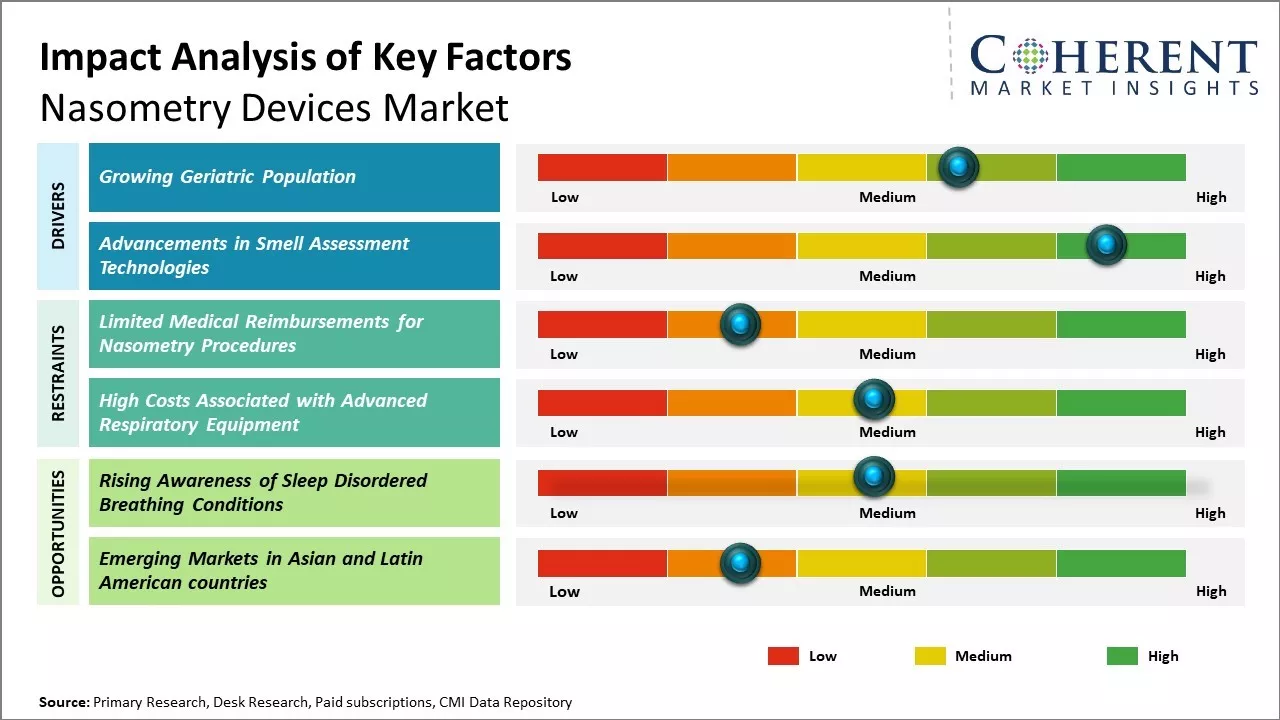
Discover market dynamics shaping the industry: Download Free Sample
The global nasometry devices market is expected to witness significant growth during the forecast period. This is attributed to the rising prevalence of nasal diseases such as nasal deformities, chronic rhinosinusitis (CRS), and nasal obstruction. Nasometry devices help in the accurate assessment and evaluation of nasal airway which further helps physicians in determining appropriate surgical procedures and treatment. Technological advancements in these devices, increasing awareness regarding nasal diseases, and growing adoption of minimally invasive Ear, Nose and Throat (ENT) procedures are further expected to propel the market growth. However, high costs of these devices and inadequate reimbursement policies may hinder the market growth to some extent during the analysis period.
Growing Geriatric Population
As life expectancy continues to increase globally, the aged population is growing at an accelerated pace. Older individuals are more prone to develop nasal issues, such as nasal obstruction, hyposmia, chronic sinusitis, allergic rhinitis, and polyps, due to a weaker immune system and other age-related health changes. This has substantially boosted the clinical significance of olfaction assessment in elderly care. Nasometry devices enable the objective and standardized evaluation of sense of smell in older adults, which is crucial in the early diagnosis of neurodegenerative disorders such as Parkinson's and Alzheimer's disease. Furthermore, loss of sense of smell can negatively impact nutritional habits and quality of life. Therefore, growing geriatric demographic demanding smell assessment solutions is primed to drive the nasometry devices market.
Market Concentration and Competitive Landscape
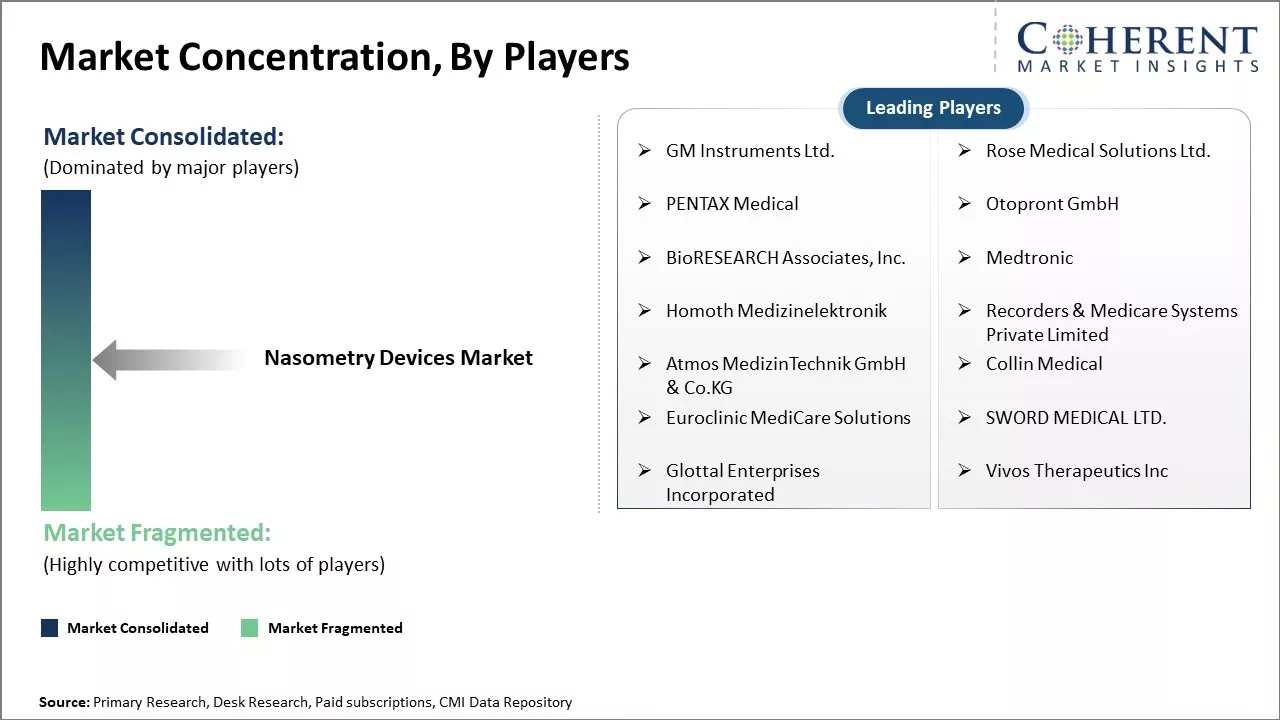
Get actionable strategies to beat competition: Download Free Sample
Advancements in Smell Assessment TechnologiesTraditional smell identification tests relying on felt-tip pens or scratch-and-sniff booklets lacked standardization and afforded only qualitative analyses. However, the introduction of advanced computerized nasometry systems equipped with multiple cartridges emitting standardized odorants has enabled quantitative measurement of olfactory functions. These systems analyze variables such as odor identification, detection threshold, and odor memory. Their ease of use and ability to generate reproducible printouts of olfactory test results have boosted their adoption across clinical research centers and smell clinics. Furthermore, continuous efforts to enhance software interfaces and optimize functionalities such as remote data collection are making smell testing more practical and accessible. This is expected to bolster the demand for technologically sophisticated nasometry devices with improved efficiency and reliability.
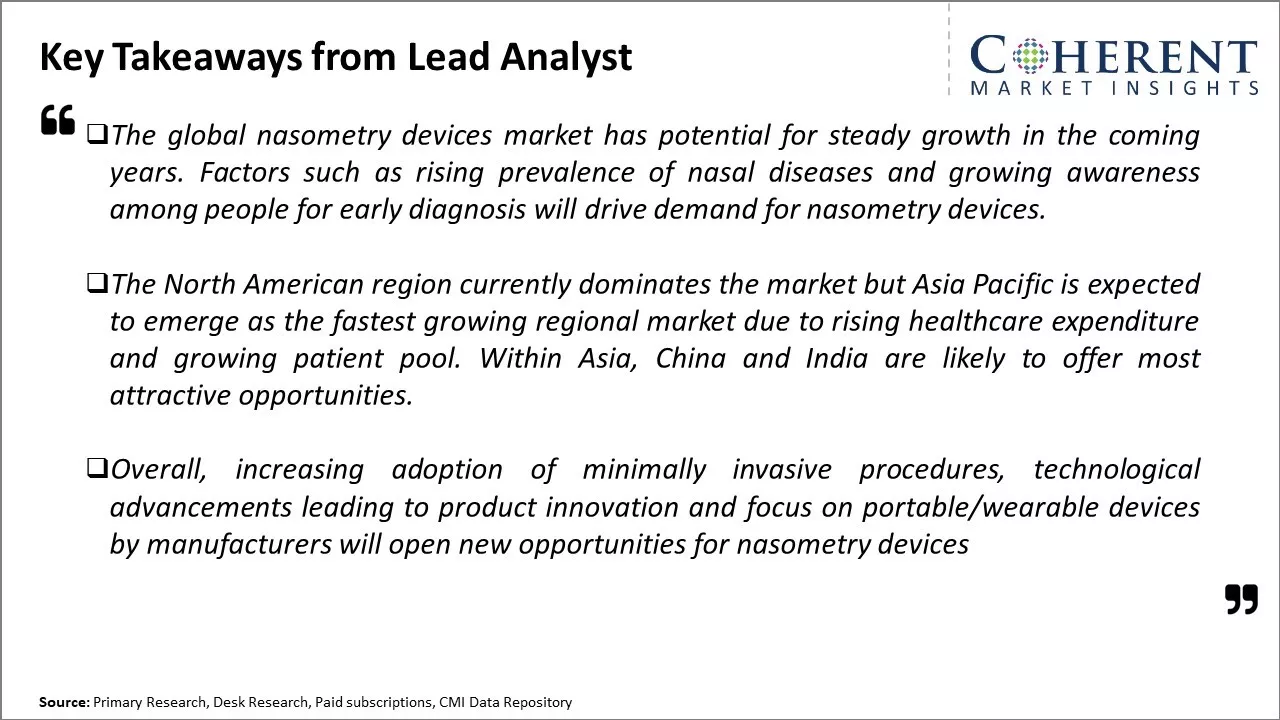
To learn more about this report, Download Free Sample
Market Challenges – High Costs of Nasometry SystemsOne of the key challenges faced by the nasometry devices market is the high cost of these systems. Nasometry devices can range significantly in price depending on the type of technology and additional features. This high cost poses a barrier for widespread adoption, particularly in cost-sensitive healthcare environments. Additional challenges include a lack of reimbursement for these devices in some regions and a need for more clinical evidence on applications and accurate measurements. Some physicians also have concerns over the usability and accuracy of certain nasometry technologies.
Market Opportunities – Rising Awareness of Sleep Disordered Breathing Conditions
The nasometry devices market also presents several opportunities for growth. With rising awareness of sleep disordered breathing conditions, demand is increasing for diagnostic tools like nasometry. Additionally, nasometry offers potential cost savings compared to traditional lab-based polysomnography. As clinical evidence expands, reimbursement and acceptance of nasometry are likely to improve as well.
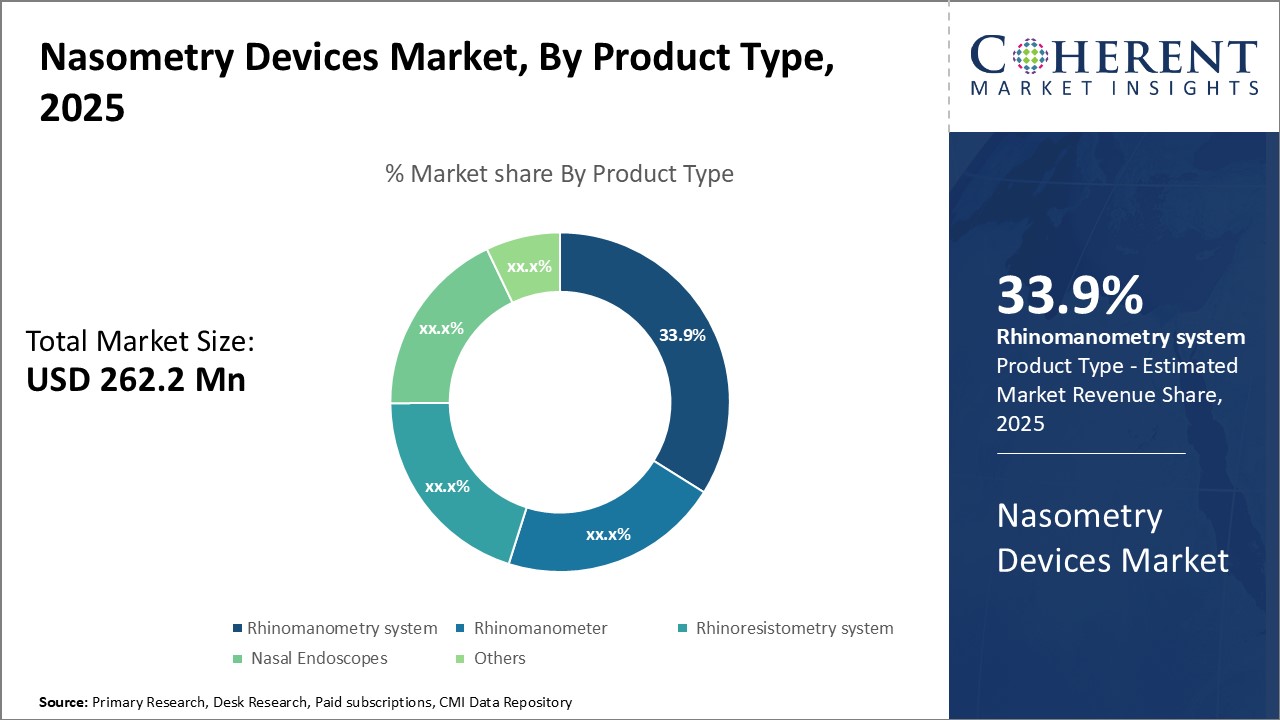
Discover high revenue pocket segments and roadmap to it: Download Free Sample
Insights, By Product Type: Growing Adoption of Non-invasive Diagnostic ToolsThe product type segment includes rhinomanometry system, rhinomanometer, rhinoresistometry system, nasal endoscopes, and others. The rhinomanometry system segment is estimated to hold 33.9% share of the market in 2025 owing to its non-invasive nature and effectiveness in measuring nasal airflow and resistance. Rhinomanometry helps determine patency of nasal passages which is crucial for diagnosing nasal blockage issues. Unlike other invasive tools, it does not require placing any probes inside nasal cavity and gives accurate readings in a quick and safe manner. Rhinomanometry system is seeing higher acceptance among ENT specialists as it alleviates patients' pain and discomfort during nasal examination. Various technological advancements like integration of sensors, software for automated calculations and recording capabilities have further optimized rhinomanometry procedures. This has strengthened its position as gold standard for objective nasal assessment. Growing awareness about advantages of rhinomanometry over other nasal diagnostic methods will continue aiding its dominance in the nasometry devices market.
Insights, By Modality: Portability and Ease of Use Boosts Popularity
The modality segment includes portable and stationary. The portable sub-segment is expected to hold 52.5% of the market share in 2025 owing to increased focus on portability and ease of use. Portable variants offer hassle-free handling and transportation within clinics as well as to patient bedsides and operation theatres. This proves beneficial especially for examining pediatric patients and individuals with low mobility. Moreover, portable rhinomanometers enable continuous monitoring and multi-point assessment during surgical routines or therapy cycles. Their rechargeable batteries provide long runtime without the need for constant power connection. Advanced portable models are also integrated with touchscreens and wireless connectivity for enhanced user-interface and remote data access. Such user-friendly attributes have garnered widespread popularity among healthcare providers targeting convenient nasal examination.
Insights, By End User: Growth in Ambulatory Surgeries Boosts Demand
The end user segment includes hospitals, specialty clinics, ambulatory surgical centers, and others. The hospitals sub-segment is expected to hold 34.4% of the market share in 2025 owing to the increasing adoption of nasometry devices in hospitals is primarily driven by large patient footfalls and surgeries for sinus, allergy, and sleep disorders treatment. Moreover, rise in ambulatory surgical centers for conducting ENT procedures in an outpatient setting has also augmented their demand. Ambulatory centers are economical treatment options for patients while easing burden on hospitals. This has strengthened hospitals as well as ambulatory surgical centers as major end users. Additionally, growing awareness about nasal disorders and available diagnostic methods has increased referrals to ENT specialists and specialty clinics. This, in turn, is spurring the installation of rhinomanometry systems in their facilities for comprehensive nasal examination of patients.
Regional Insights
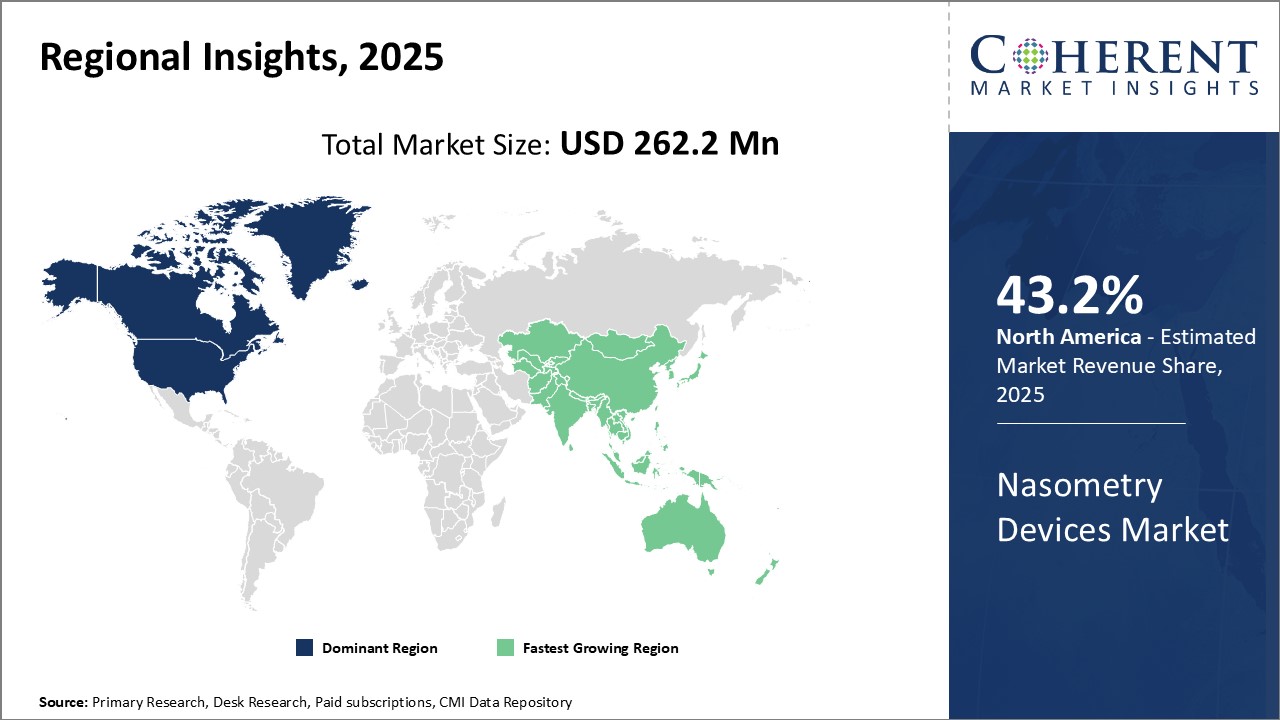
Need a Different Region or Segment? Download Free Sample
North America remains the dominant region in the global nasometry devices market and is anticipated to hold 43.2% of the market share in 2025. North America has traditionally been the dominant region in the nasometry devices market. The large size of the U.S. healthcare industry as well as the presence of many leading medical device manufacturers has cemented North America's position at the top. Devices produced by the U.S. companies such as Acoustic Rhinometry and Innovia Medical made high sales across the U.S. and Canadian markets due to brand awareness and reputation. Further boosting the region's market share is the availability of favorable reimbursement policies for device-based procedures. This makes nasometry tests more affordable for patients, driving higher demand.
Asia Pacific has emerged as the fastest growing regional market over the past five years. Countries like India, China, and Japan are witnessing rapid development of their healthcare infrastructure and rising access to specialized treatments. This has provided the environment for local companies in Aisa Pacific to enter the nasometry devices field and gain ground. For example, Neometrics, an India-based company, achieved success in selling its budget-friendly nasometry kits to clinics and hospitals across South Asia. Import restrictions on certain medical goods have also driven production localization in the region.
Market Report Scope
Nasometry Devices Market Report Coverage
| Report Coverage | Details | ||
|---|---|---|---|
| Base Year: | 2024 | Market Size in 2025: | USD 262.2 Mn |
| Historical Data for: | 2020 To 2024 | Forecast Period: | 2025 To 2032 |
| Forecast Period 2025 to 2032 CAGR: | 4.5% | 2032 Value Projection: | USD 357.1 Mn |
| Geographies covered: |
|
||
| Segments covered: |
|
||
| Companies covered: |
GM Instruments Ltd., Rose Medical Solutions Ltd., PENTAX Medical, Otopront GmbH, BioRESEARCH Associates, Inc., Medtronic, Homoth Medizinelektronik, Recorders & Medicare Systems Private Limited, Atmos MedizinTechnik GmbH & Co.KG, Collin Medical, Euroclinic MediCare Solutions, SWORD MEDICAL LTD., Glottal Enterprises Incorporated, and Vivos Therapeutics Inc |
||
| Growth Drivers: |
|
||
| Restraints & Challenges: |
|
||
Uncover macros and micros vetted on 75+ parameters: Get instant access to report
Nasometry Devices Industry News
- In June 2022, Vivos Therapeutics Inc, a medical technology company focused on developing treatments for patients suffering from dentofacial abnormalities and/or mild to moderate obstructive sleep apnea (OSA) and snoring in adults, announced that it had entered into an exclusive distribution agreement with GM Instruments Ltd., a medical device company, for the distribution of GM Instruments’ NR6 Rhinomanometer, in the U.S. used to calculate nasal airway resistance by measuring nasal flow and the pressure producing that flow. Under the terms of agreements, Vivos Therapeutics Inc became the distributor of NR6 Rhinomanometer.
*Definition: Nasometry devices are the medical devices that measure aspects of the nose and nasal airflow. Nasometry devices help diagnose and treat conditions that affect the nose such as nasal obstructions from polyps or allergies and breathing-related sleep disorders. Key nasometry devices include active anterior rhinomanometry devices, acoustic rhinometry systems, and nasal inspection cameras. These devices provide objective measurements of the nasal cycle, airflow patterns, and internal nasal appearances to help ENT specialists evaluate and track nasal health.
Market Segmentation
- Product Type Insights (Revenue, USD Mn, 2020 - 2032)
- Rhinomanometry system
- Rhinomanometer
- Rhinoresistometry system
- Nasal Endoscopes
- Others
- Modality Insights (Revenue, USD Mn, 2020 - 2032)
- Portable
- Stationary
- End User Insights (Revenue, USD Mn, 2020 - 2032)
- Hospitals
- Specialty Clinics
- Ambulatory Surgical Centers
- Others
- Regional Insights (Revenue, USD Mn, 2020 - 2032)
- North America
- U.S.
- Canada
- Latin America
- Brazil
- Argentina
- Mexico
- Rest of Latin America
- Europe
- Germany
- U.K.
- Spain
- France
- Italy
- Russia
- Rest of Europe
- Asia Pacific
- China
- India
- Japan
- Australia
- South Korea
- ASEAN
- Rest of Asia Pacific
- Middle East
- GCC Countries
- Israel
- Rest of Middle East
- Africa
- South Africa
- North Africa
- Central Africa
- North America
- Key Players Insights
- GM Instruments Ltd.
- Rose Medical Solutions Ltd.
- PENTAX Medical
- Otopront GmbH
- BioRESEARCH Associates, Inc.
- Medtronic
- Homoth Medizinelektronik
- Recorders & Medicare Systems Private Limited
- Atmos MedizinTechnik GmbH & Co.KG
- Collin Medical
- Euroclinic MediCare Solutions
- SWORD MEDICAL LTD.
- Glottal Enterprises Incorporated
- Vivos Therapeutics Inc
Share
Share
About Author
Manisha Vibhute is a consultant with over 5 years of experience in market research and consulting. With a strong understanding of market dynamics, Manisha assists clients in developing effective market access strategies. She helps medical device companies navigate pricing, reimbursement, and regulatory pathways to ensure successful product launches.
Missing comfort of reading report in your local language? Find your preferred language :
Transform your Strategy with Exclusive Trending Reports :
Frequently Asked Questions
EXISTING CLIENTELE
Joining thousands of companies around the world committed to making the Excellent Business Solutions.
View All Our Clients
